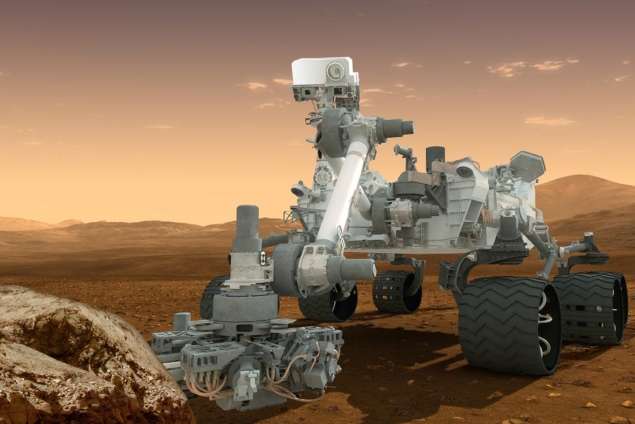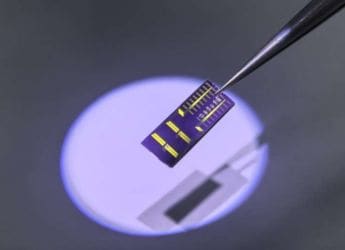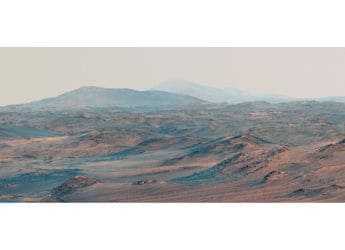- Home
- Others
- Others News
- NASA's Curiosity rover celebrates one year on Mars
NASA's Curiosity rover celebrates one year on Mars

If microbes ever existed on Mars, the mountain represents the best hope for preserving the chemical ingredients that are fundamental to all living things.
After a poky but productive start, Curiosity recently pointed its wheels south, rolling toward the base of Mount Sharp in a journey that will last many months. Expect Curiosity to channel its inner tourist as it drives across the rock-strewn landscape, dodging bumps and taking in the scenery.
"We do a lot of off-roading on a lot of little dirt roads," said mission manager Jennifer Trosper.
Curiosity will unpack its toolkit once it arrives at its destination to hunt for the organic building blocks of life.
Scientists have been eager for a peek of Mount Sharp since Curiosity, the size of a small SUV, touched down in an ancient crater near the Martian equator on the night of Aug. 5, 2012.
(Also see: Mars rover Curiosity lands on surface of Red Planet)
The world wondered whether Curiosity would nail its landing, which involved an acrobatic plunge through the thin atmosphere that ended with it being gently lowered to the ground with cables.
Engineers had to invent new tricks since Curiosity was too massive to bounce to a landing cocooned in airbags - the preferred choice for previous rovers Spirit and Opportunity.
After seven terrifying minutes, a voice echoed through mission control at the NASA Jet Propulsion Laboratory. "Touchdown confirmed," said engineer Allen Chen. "We're safe on Mars."
(Also see: I'm safely on Mars, says rover tweet)
Scientists and engineers clad in matching sky-blue polo shirts erupted in cheers. Some were so excited that they overshot their high-fives.
Curiosity became a pop sensation. Several of Curiosity's handlers including Bobak "Mohawk Guy" Ferdowsi became science rock stars.
The technical prowess required to pull off such a landing has "captured the imagination of a whole new generation of prospective explorers," said American University space policy professor Howard McCurdy, who has closely followed the $2.5 billion mission.
Mission scientist Sushil Atreya of the University of Michigan remained calm until the last ten seconds. "Then it hit me - it's crazy! It was an unbelievable feeling of relief when the first picture from the rover came down," Atreya said.
Mike Malin, who operates Curiosity's cameras, ticked off two of his favorite pictures from the mission so far: A view of the rover's heat shield falling away right before landing and a color portrait of Mount Sharp.
"That looks so much like Utah that it felt very familiar," said Malin, who heads Malin Space Science Systems.
Once the euphoria of landing wore off, the six-wheel, nuclear-powered rover went to work, spending two months testing its instruments and systems. The health checks took longer than expected because Curiosity was a complex machine.
To celebrate the landing anniversary, engineers commanded one of Curiosity's instruments to play "Happy Birthday" as the rover took a break from driving.
Scientists initially hoped to head to Mount Sharp late last year, but decided to take a detour to an intriguing spot near the landing site where three different types of terrain intersected.
Curiosity discovered rounded pebbles - clear evidence of an ancient streambed. It also fulfilled one of the mission's main goals. By drilling into a rock and analyzing its chemistry, Curiosity concluded that Gale Crater possessed the right environmental conditions to support primitive life. It's not equipped to look for microbes, living or extinct.
(Also see: NASA's Curiosity rover gets first Mars rock samples)
With Curiosity busy studying rocks and dirt, the start date for the mountain trek kept getting pushed back. At one point, the team declined to predict anymore.
Now that it's finally on the move, scientists hope to keep stops to a minimum. Along the way, Curiosity will take pictures, check the weather, track radiation and fire its laser at rocks.
Curiosity was such a smash that NASA is preparing for an encore performance in 2021 using the same landing technology. Budget willing, the next rover will be able to collect rocks and store them on the Martian surface for a possible future mission to pick up and ferry back to Earth.
Get your daily dose of tech news, reviews, and insights, in under 80 characters on Gadgets 360 Turbo. Connect with fellow tech lovers on our Forum. Follow us on X, Facebook, WhatsApp, Threads and Google News for instant updates. Catch all the action on our YouTube channel.
Related Stories
- Samsung Galaxy Unpacked 2025
- ChatGPT
- Redmi Note 14 Pro+
- iPhone 16
- Apple Vision Pro
- Oneplus 12
- OnePlus Nord CE 3 Lite 5G
- iPhone 13
- Xiaomi 14 Pro
- Oppo Find N3
- Tecno Spark Go (2023)
- Realme V30
- Best Phones Under 25000
- Samsung Galaxy S24 Series
- Cryptocurrency
- iQoo 12
- Samsung Galaxy S24 Ultra
- Giottus
- Samsung Galaxy Z Flip 5
- Apple 'Scary Fast'
- Housefull 5
- GoPro Hero 12 Black Review
- Invincible Season 2
- JioGlass
- HD Ready TV
- Laptop Under 50000
- Smartwatch Under 10000
- Latest Mobile Phones
- Compare Phones
- OnePlus 15R
- Realme Narzo 90x 5G
- Realme Narzo 90 5G
- Vivo S50 Pro Mini
- Vivo S50
- OPPO Reno 15c
- Redmi Note 15 5G
- Redmi Note 15 Pro 5G
- Asus ProArt P16
- MacBook Pro 14-inch (M5, 2025)
- Infinix Xpad Edge
- OnePlus Pad Go 2
- OnePlus Watch Lite
- Just Corseca Skywatch Pro
- Acerpure Nitro Z Series 100-inch QLED TV
- Samsung 43 Inch LED Ultra HD (4K) Smart TV (UA43UE81AFULXL)
- Asus ROG Ally
- Nintendo Switch Lite
- Haier 1.6 Ton 5 Star Inverter Split AC (HSU19G-MZAID5BN-INV)
- Haier 1.6 Ton 5 Star Inverter Split AC (HSU19G-MZAIM5BN-INV)

















